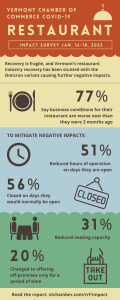Accessory Dwelling Units See Funding Moved
The Senate Economic Development, Housing and General Affairs Committee reviewed a proposal to allow homeowners to create Accessory Dwelling Units (ADUs) within their home or on their property. State statute currently allows for ADUs, but the Committee is assessing how to incentivize, educate homeowners, and finance these units. It was encouraging that the Committee and witnesses were cognizant of this conversation in terms of the housing crisis and using state resources to create long term housing solutions and not add to Vermont’s growing short term rental stock. The Committee discussed the requirements for owner occupancy and local bylaws to address this. The Vermont Chamber supports efforts to increase units of housing stock in Vermont, which will provide the workforce with affordable and suitable housing opportunities.
The Governor’s proposal for increased funding for a program that can help with ADUs was removed from the Budget Adjustment Act (BAA) by Senate Appropriation. Twenty million dollars for the Vermont Rental Housing Investment Program (VRHIP), which provides funding to upgrade rental units and create ADUs, was passed by the House in the BAA but was removed by the Senate Appropriation Committee in order to combine the program language currently in S.210 with the money for it. Last year program funding was approved but program language was vetoed. Consideration of S.210 has been postponed by the Senate until February 8.
SHARE THIS ARTICLE
RECENT NEWS



